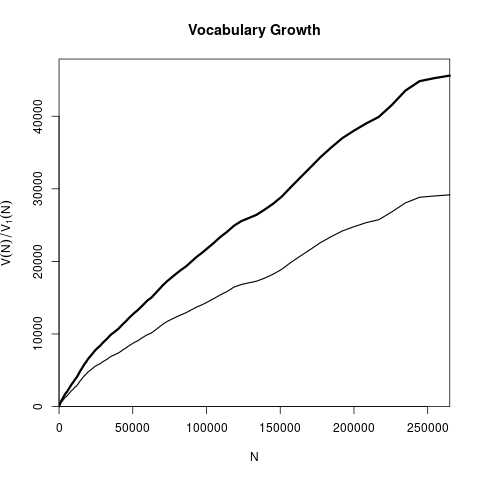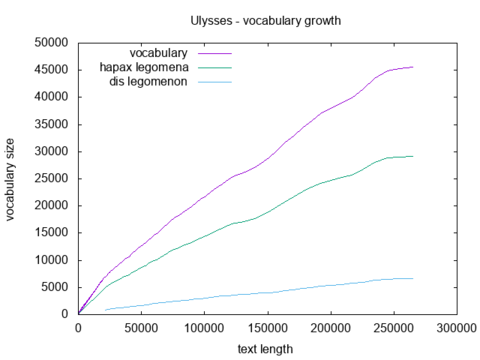clscripts
Repository for computational linguistics scripts (bash, python, octave, R, etc).
vgc.py
Create vocabulary growth curve data, compatible with zipfR package. Like heaps.py, it provides the first column with text length, the second with vocabulary size and subsequent columns display the number of types appearing from 1 to N times, where N is given by using the -V parameter.
script usage
Help shows the usage syntax and available parameters.
$ ./vgc.py --help
usage: vgc.py [-h] [-m MAXLEN] [-s SAMPLES] [-l] [-i FILE] [-V LEGOMENON] [-c]
optional arguments:
-h, --help show this help message and exit
-m MAXLEN, --maxlen MAXLEN
Maximum length of the sample that will be analyzed.
-s SAMPLES, --samples SAMPLES
Number of points in the output (linearly spaced or
logarithmically spaced). Use Inf or All to print every
single sample.
-l, --log Use logarithmic spaced samples.
-i FILE, --input FILE
Input text file name.
-V LEGOMENON, --legomenon LEGOMENON
Number of types in the corresponding frequency classes
at the specified Ns (-V 1: hapax legomena, -V 2: hapax
and dis legomenon, -V 3: hapax, dis and tris
legomenon, etc).
-c, --counts Print only counts (remove header)
usage examples
For the basic usage, just provide the text file as input. The example below present the first and last 5 lines of the result.
$ ./vgc.py -i ulysses.txt | (head -5; echo "..."; tail -5)
N V V1
1 1 1
2 2 2
3 3 3
4 4 4
...
265062 45457 29036
265063 45457 29036
265064 45457 29036
265065 45458 29037
265066 45459 29038
You can also read text from stdin, as illustrated in the example below.
$ ./vgc.py --maxlen 10 -V 3 < ulysses.txt
N V V1 V2 V3
1 1 1 0 0
2 2 2 0 0
3 3 3 0 0
4 4 4 0 0
5 5 5 0 0
6 6 6 0 0
7 7 7 0 0
8 8 8 0 0
9 9 9 0 0
10 9 8 1 0
The result might be saved into a file and plotted. The example below uses R to plot the vocabulary growth in Ulysses by James Joyce.
$ ./vgc.py -i ulysses.txt --samples 256 --log -V 3 > ulysses.vgc
$ R
> uvgc = read.vgc('ulysses.vgc')
> png('ulysses_vgc.png')
> plot(uvgc, add.m=1)
> dev.off()

Or it might be done directly in shell using gnuplot:
$ ./vgc.py -i ulysses.txt --samples 256 --log -V 3 -c |
awk -- '{print $0} END{print "e"}' |
tee -i -a /dev/stdout /dev/stdout |
gnuplot -e "set terminal png; set output 'ulysses_vgc2.png'; set xlabel 'text length'; set ylabel 'vocabulary size'; set title 'Ulysses - vocabulary growth'; set key left top; plot '-' using 1:2 with lines title 'vocabulary', '-' using 1:3 with lines title 'hapax legomena', '-' using 1:4 with lines title 'dis legomenon'"
awk was used just to add an e to the end. tee was used to replicate the stdout since gnuplot needs one data for each line.
